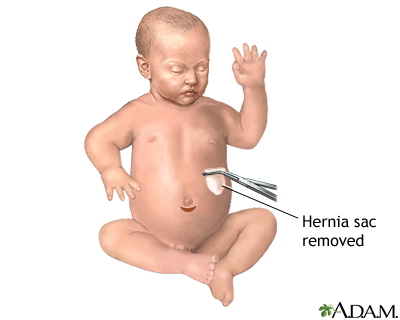Health Library
Umbilical hernia repair - series

Normal anatomy
The umbilicus ("belly button") is in the center of the lower abdomen. It is the site through which vessels which provide nutrients to the fetus from the mother during development penetrate the fetal abdominal wall.

Indications
Umbilical hernias are fairly common. They are obvious at birth and are caused by a small defect in the abdominal muscles which allows a portion of the peritoneum (lining of the abdominal cavity) to protrude, and push the umbilicus outward. This is more obvious when the infant cries and the increased pressure results in more visible bulging. The defect is not usually treated surgically. In most cases, by age 3 the umbilical hernia shrinks and closes without treatment.
The indications for umbilical hernia repair include:
- Incarcerated (strangulated) umbilical hernia
- Defects not spontaneously closed by 4 to 5 years of age
- Children under 2 with very large defects unacceptable to parents for cosmetic reasons

Incision
General anesthesia is used. A curved incision is made under the umbilicus.

Procedure
The hernia sac is identified and dissected from the underlying tissues, and cut out. The underlying tissues are then closed with strong nonabsorbable sutures. Skin edges are held with paper tape (steri-strips). The surgical scar should be hidden in the umbilical depression.

Aftercare
Children can usually go home within one to two days of an umbilical hernia repair. Recurrence is rare.
Related Information
Umbilical hernia repairBACK TO TOP
Review Date: 1/24/2023
Reviewed By: Robert A. Cowles, MD, Professor of Surgery (Pediatrics), Yale University School of Medicine, New Haven, CT. Review provided by VeriMed Healthcare Network. Also reviewed by David C. Dugdale, MD, Medical Director, Brenda Conaway, Editorial Director, and the A.D.A.M. Editorial team.
 | A.D.A.M., Inc. is accredited by URAC, for Health Content Provider (www.urac.org). URAC's accreditation program is an independent audit to verify that A.D.A.M. follows rigorous standards of quality and accountability. A.D.A.M. is among the first to achieve this important distinction for online health information and services. Learn more about A.D.A.M.'s editorial policy, editorial process and privacy policy. A.D.A.M. is also a founding member of Hi-Ethics. This site complies with the HONcode standard for trustworthy health information: verify here. |
The information provided herein should not be used during any medical emergency or for the diagnosis or treatment of any medical condition. A licensed medical professional should be consulted for diagnosis and treatment of any and all medical conditions. Links to other sites are provided for information only -- they do not constitute endorsements of those other sites. No warranty of any kind, either expressed or implied, is made as to the accuracy, reliability, timeliness, or correctness of any translations made by a third-party service of the information provided herein into any other language. © 1997- 2024 A.D.A.M., a business unit of Ebix, Inc. Any duplication or distribution of the information contained herein is strictly prohibited.
